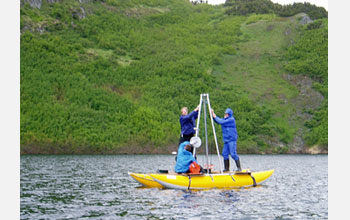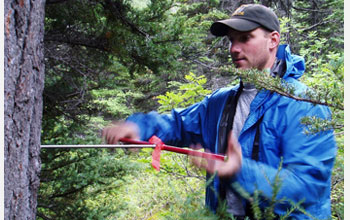All Images
News Release 09-166
The Arctic Offers More Evidence of Human Influences on Climate Change
Recent, sudden and dramatic Arctic warming was preceded by almost 2,000 years of natural cooling
This material is available primarily for archival purposes. Telephone numbers or other contact information may be out of date; please see current contact information at media contacts.

Researchers (R.S. Anderson, A. Werner and T. Diagle) take a sediment core from the bottom of Goat Lake in south-central Alaska, which is 50 meters below the surface.
Credit: Darrell Kaufman, Northern Arizona University
Download the high-resolution JPG version of the image. (482 KB)
Use your mouse to right-click (Mac users may need to Ctrl-click) the link above and choose the option that will save the file or target to your computer.
Darrell Kaufman summarizes study results.
Credit: National Science Foundation, Northern Arizona University
Darrell Kaufman explains Arctic sensitivity to climate change.
Credit: National Science Foundation, Northern Arizona University
Darrell Kaufman explains importance of lake evidence.
Credit: National Science Foundation, Northern Arizona University
Darrell Kaufman explains complexities of study.
Credit: National Science Foundation, Northern Arizona University
Darrell Kaufman discusses future studies.
Credit: National Science Foundation, Northern Arizona University

How a wobble in the Earth's axis of rotation caused a cooling trend that lasted at least 1,900 years.
Credit: Zina Deretsky, NSF
Download the high-resolution JPG version of the image. (368 KB)
Use your mouse to right-click (Mac users may need to Ctrl-click) the link above and choose the option that will save the file or target to your computer.

Coring tree: A hemlock tree is bored by a researcher (T. Daigle) in south-central Alaska. The width of the annual rings of trees can be used to infer past changes in growing season temperatures.
Credit: Darrell Kaufman, Northern Arizona University.
Download the high-resolution JPG version of the image. (697 KB)
Use your mouse to right-click (Mac users may need to Ctrl-click) the link above and choose the option that will save the file or target to your computer.

A new sediment core from Cub Lake in south-central Alaska shows multiple layers of volcanic ash. Sediment cores from lakes in volcanically active regions reveal information about past climate change as well as the eruptive histories of volcanoes.
Credit: Darrell Kaufman, Northern Arizona University
Download the high-resolution JPG version of the image. (1.2 MB)
Use your mouse to right-click (Mac users may need to Ctrl-click) the link above and choose the option that will save the file or target to your computer.

The previous extent of a glacier that feeds Upper Greyling Lake in south-central Alaska is marked by the sharp-crested ridges of debris (lateral moraines) that descend into the lake. Glacial history is combined with other evidence, such as lake-core evidence, to reconstruct climate history.
Credit: Darrell Kaufman, Northern Arizona University
Download the high-resolution JPG version of the image. (743 KB)
Use your mouse to right-click (Mac users may need to Ctrl-click) the link above and choose the option that will save the file or target to your computer.

The researchers' findings appear in the Sept. 4, 2009, issue of Science magazine.
Credit: Copyright 2009 AAAS
Download the high-resolution JPG version of the image. (770 KB)
Use your mouse to right-click (Mac users may need to Ctrl-click) the link above and choose the option that will save the file or target to your computer.


